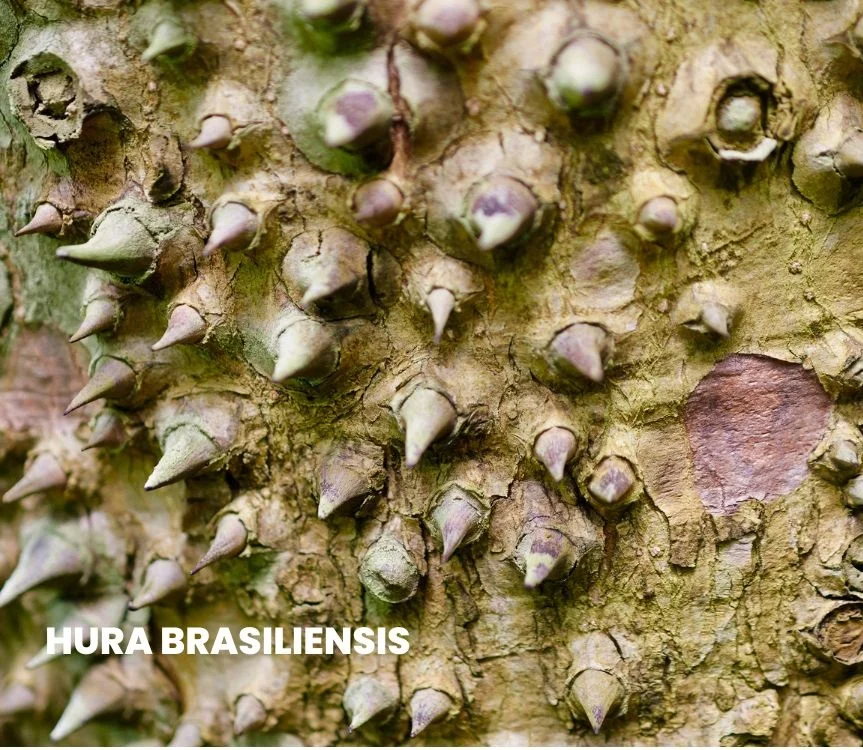Hura Brasiliensis, commonly known as Assacu, is a plant indigenous to tropical regions of South America, particularly found in Brazil and parts of the Amazon rainforest.
This plant has garnered attention in both traditional medicine and homeopathy due to its unique therapeutic properties, especially in treating leprosy and associated skin conditions.
Hura Brasiliensis is noted for its specific symptomatology, which includes sensations of tightness in the skin and peculiar dermatological manifestations.

Table of Contents
ToggleSOURCE INFORMATION
Scientific Classification
- Kingdom: Plantae
- Clade: Angiosperms
- Clade: Eudicots
- Clade: Rosids
- Order: Euphorbiales
- Family: Euphorbiaceae
- Genus: Hura
- Species: Hura Brasiliensis
Origin
- Hura Brasiliensis is a native plant of the Amazon basin, thriving in tropical climates.
- The plant is part of the Euphorbiaceae family, which is known for its wide variety of species, some of which possess medicinal properties.
- Historically, the indigenous populations of Brazil have utilized this plant for its therapeutic effects, particularly in treating skin diseases, including leprosy.
Historical Facts
- The use of Hura Brasiliensis dates back to ancient times, where it was recognized by local tribes for its medicinal value.
- In homeopathy, Hura Brasiliensis was introduced as a remedy for leprosy and associated skin conditions in the late 19th century.
- The plant’s latex has been studied for its potential applications in treating various skin afflictions.
DRUG PATHOGENESIS
Hura Brasiliensis exhibits specific therapeutic actions on the skin and musculoskeletal systems.
The primary effects noted include:
- Skin: The remedy addresses conditions where the skin exhibits tightness, dryness, and unusual sensations such as throbbing or itchiness.
- This indicates an underlying disturbance in the skin’s integrity and elasticity.
- Musculoskeletal System: Symptoms like stiffness in the neck and back pain suggest a connection between the nervous system and muscular tensions, likely influenced by the remedy’s action on the body’s connective tissues.
DIATHESIS
- Hura Brasiliensis is particularly suited for individuals with a syphilitic diathesis, characterized by chronic and degenerative diseases, skin afflictions, and systemic involvement.
- This diathesis may manifest as a result of past infections or hereditary factors.
TEMPERAMENTS
- The remedy is often beneficial for individuals with a sensitive temperament, who may be more susceptible to environmental changes and stressors.
KEY CHARACTERISTICS
- Skin Symptoms: The hallmark of Hura Brasiliensis is its action on leprosy, manifesting as tight, hide-bound skin, tense vesicles, and a sensation of splinters under the nails.
- Muscle and Joint Pain: Stiff neck and back pain accompany the skin symptoms, indicating a connection between the nervous system and muscular tension.
- Nervous Symptoms: Throbbing sensations in the fingertips and itching around bony protrusions suggest heightened nerve sensitivity.
DETAILED ORGAN SYMPTOMS
SKIN
- Tightness and Sensation of Being Hide-Bound: Patients often describe their skin as feeling tight and restricted, which is indicative of a loss of elasticity and hydration.
- Tense Vesicles: The presence of vesicles suggests inflammation or irritation of the skin, often accompanying infectious processes.
- Itching and Pimples: These symptoms often occur on bony prominences, indicating irritation of the dermal layers.
MUSCULOSKELETAL SYSTEM
- Stiff Neck and Back Pain: These symptoms reflect potential muscular tension and discomfort, likely exacerbated by the overall condition of the skin.
NEUROLOGICAL SYMPTOMS
- Throbbing in Fingertips: This suggests increased sensitivity or irritation of the peripheral nerves, possibly due to systemic infection or inflammation.
MODALITIES
- Worse: The symptoms tend to worsen in humid conditions and may be aggravated by stress and emotional disturbances.
- Better: Patients may find relief in cooler, drier environments.
RELATIONSHIP WITH OTHER DRUGS
Compare,
- Calotropis: Useful for similar symptoms in leprosy, specifically those with livid and gangrenous tubercles and thickened skin.
- Madura Album: Another remedy for leprosy characterized by extensive skin involvement.
DOSE
- The usual dosage for Hura Brasiliensis is sixth potency, administered according to the severity and chronicity of symptoms.
Frequently Asked Questions
What is Hura Brasiliensis primarily used for?
- Hura Brasiliensis is mainly used for treating leprosy and its associated skin conditions, characterized by tight skin and vesicular eruptions.
Are there any side effects associated with Hura Brasiliensis?
- As with any homeopathic remedy, side effects are minimal when used appropriately.
- However, patients should monitor their symptoms and consult a healthcare provider if adverse reactions occur.
Can Hura Brasiliensis be used for other conditions apart from leprosy?
- While it is primarily indicated for leprosy, it may also help with other skin conditions and musculoskeletal issues related to nerve sensitivity.
How should Hura Brasiliensis be taken?
- The remedy can be taken in the form of tincture or in homeopathic pellets, adhering to the prescribed dosage of sixth potency.
Glossary of Terms
- Erythema: Redness of the skin caused by increased blood flow.
- Vesicle: A small fluid-filled sac on the skin.
- Throbbing: A rhythmic beating or pulsing sensation, often associated with pain.
- Taut: Stretched or pulled tight.
This comprehensive overview serves as a guide to understanding Hura Brasiliensis, its therapeutic applications, and its significance in homeopathy, particularly for conditions such as leprosy.
Always consult a qualified healthcare professional before starting any new treatment.
